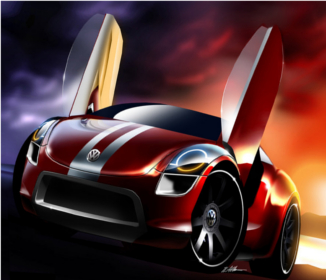Top Gear is a British institution. The much-loved motoring show attracts millions of viewers every week on BBC and has become a success in 170 different countries with a fan base of over 350 million people.
Despite having a macho persona, with three male presenters – Jeremy Clarkson, Richard Hammond and James May – Top Gear has developed a large number of female motoring fans after featuring female celebrities such as Helen Mirren, Cameron Diaz and Jodie Kidd as guests taking on the challenge of “star in reasonably priced car”, which involves famous people driving a very ordinary car around the Top Gear track as quickly as possible.
Since 2002, the show has been filmed in a studio with a live studio audience and has become known for its various hair brain challenges and quirky, but sometimes controversial, sense of humour. However, the earlier version of Top Gear, which began life in 1977, was much different.
History
Top Gear started life as a BBC television magazine series profiling the newest and best cars of the day. It was filmed in Pebble Mill and was a 30-minute format presented by a number of different people such as Noel Edmonds, William Woollard, Angela Rippon and Sue Barker. All car issues were covered from motorsport to road safety, although they were covered in a lot more seriousness than today’s series’.
The show’s format was popular and remained the same until 1987 when Jon Bentley (some of you may be familiar with him from Channel 5’s The Gadget Show and Fifth Gear) became a producer. Under Bentley’s production, Top Gear began to move towards a more humorous outlook, headed up by new presenters, one of whom was Jeremy Clarkson. The new jokey outlook on motoring was deemed controversial by some critics who thought that Top Gear was promoting irresponsible behaviour on the road, although viewers clearly didn’t agree, with viewing figures rising to an all-time high and topping the 5 million mark.
Throughout the 1990’s Top Gear has seen presenters come and go, with two notable names, used car salesman Quentin Wilson and female racing driver Vicki Butler-Henderson.
By the year 2000, Top Gear began to steadily fall in the ratings, coinciding with the departure of Jeremy Clarkson, who happened to be replaced by one James May. Kate Humble also joined the show but it was too late to claw back viewers and by 2001 Top Gear as a magazine show was cancelled.
The New Format
Following the cancellation of Top Gear, Channel 5 filled the void with a new series called “Fifth Gear”, featuring many of Top Gear’s old presenters, including Quentin Wilson and Vicki Butler-Henderson. It was the success of this show that gave Jeremy Clarkson and producer Andy Wilman the idea of an hour-long studio format. Richard Hammond and Jason Dawe were enlisted to present the show alongside Clarkson. Dawe was replaced in the second series by James May, forming the presenting team that exists today.
The “Old Top Gear”, as the pre-cancellation show is known, couldn’t have been any different from the stunts, races and challenges that are featured every week in today’s format.
Alongside the presenting team is also a “tame racing driver” known as the “Stig”. Stig has become a cult hero on the show despite never talking or revealing what is under his racing helmet. The job of the Stig is simply to test drive various cars around the Top Gear track which are then timed and placed on a list of fastest laps. Challenges for the presenters range from building a convertible Renault Escape to buying a car for less than £1,500 and putting to the test in a series of tasks, there is also a running theme that involves James May, or “Captain Slow” as he is often referred to, being playfully bullied by Clarkson and Hammond.
In addition to the regular series’, Top Gear also presents a number of hour-long specials such as a USA special which involved travelling from Miami to New Orleans in a beat-up car, and the Middle East Special whereby the presenters had to follow the route of the Nativity in second-hand two seat convertibles, with hilarious consequences.
Top Gear has become much more than a car show and is simply one of the funniest and entertaining shows on television. Regardless of whether or not you have an interest in cars, Top Gear is a show that must be enjoyed by everyone.

